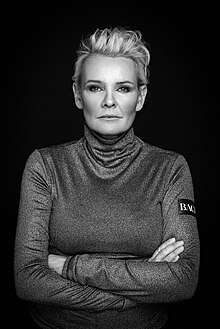Eva Dahlgren
Eva Charlotte Dahlgren (/ˈeɪvə ˈdɑːlɡrɪn/ in English; born 9 June 1960 in Umeå, Sweden) is a Swedish pop musician.
Eva Dahlgren | |
|---|---|
 Eva Dahlgren in March 2016 | |
| Background information | |
| Born | 9 June 1960 Umeå, Sweden |
| Genres | Pop |
| Occupation(s) | Singer songwriter |
| Instruments |
|
| Years active | 1978-present |
| Associated acts |
|
Dahlgren was discovered by musician/producer Bruno Glenmark in 1978 after appearing on the TV show Sveriges magasin and her debut album Finns det nån som bryr sej om was released the same year. In 1979 she placed third in Melodifestivalen (the tryout competition for the Eurovision Song Contest in Sweden). She toured Sweden in 1987 with Swedish pop duo Roxette, a tour that was attended for more than 100,000 people. Dahlgren's career grew steadily with several album releases during the 1980s but her definite breakthrough in Sweden came in 1991 with the hit album En blekt blondins hjärta which sold over half a million copies and netted the singer five Grammis awards.
In 1996 Dahlgren made headlines in the Swedish press when she came out as a lesbian through her civil union with jewellery designer Efva Attling. In connection with the civil union, Dahlgren changed her surname to Dahlgren-Attling. In 2009 they got married, after Sweden passed its gender neutral marriage law.
Eva Dahlgren toured July – August 2008 together with Peter Jöback in Sweden, Norway and Finland. The tour was called "Himlen är inget tak", and a single with the same title was released.
Discography
(In parentheses, peak positions in Swedish Albums Chart)[1]
- 1978: Finns det nån som bryr sig om (#23)
- 1980: Eva Dahlgren (#25)
- 1981: För väntan (#2)
- 1982: Tvillingskäl (#8)
- 1984: Ett fönster mot gatan (#2)
- 1984: Känn mig
- 1987: Ung och stolt (#2)
- 1989: Fria Världen 1.989 (#3)
- 1991: En blekt blondins hjärta (#1)
- 1992: Eva Dahlgren (English language version of En blekt blondins hjärta)
- 1992: För minnenas skull (double CD) (1978–1992) (#10)
- 1995: Jag vill se min älskade komma från det vilda (#2)
- 1999: Lai Lai (#1)
- 1999: LaLaLive (#5)
- 2005: Snö (#2)
- 2007: En blekt blondins ballader (1980–2005) (#1)
- 2007: Petroleum och tång (#3)
- 2016: Jag sjunger ljuset (#4)
- Compilation albums
- 2012: Tid – Urval av sånger 1980 till nu
- 2012: Original Album Classics
Singles
(In parentheses, peak positions in Swedish Singles Chart)[2]
- 1989: "Ängeln i rummet" (#4)
- (English version: "Angel in My Room")
- 1991: "Gunga mig" (#40)
- 1991: "Vem tänder stjärnorna" (#4)
- (English version: "I'm not in Love with You")
- 1991: "Kom och håll om mig" (#27)
- (English version: "Just Want You to Love Me")
- 1994: "Tro på varann" (Uno Svenningsson and Eva Dahlgren (#22)
- 1999: "Underbara människa" (#41)
- 2005: "När jag längtar" (#17)
- 2006: "Äventyr" (EP) (#58)
- 2008: "Himlen är inget tak" (Eva Dahlgren and Peter Jöback) (#36)
References
- "Swedish charts archive – albums". Retrieved 6 January 2012.
- "Swedish charts archive – singles". Retrieved 6 January 2012.
External links
| Wikimedia Commons has media related to Eva Dahlgren. |
- Eva Dahlgren Online
- (in Swedish)Official web site